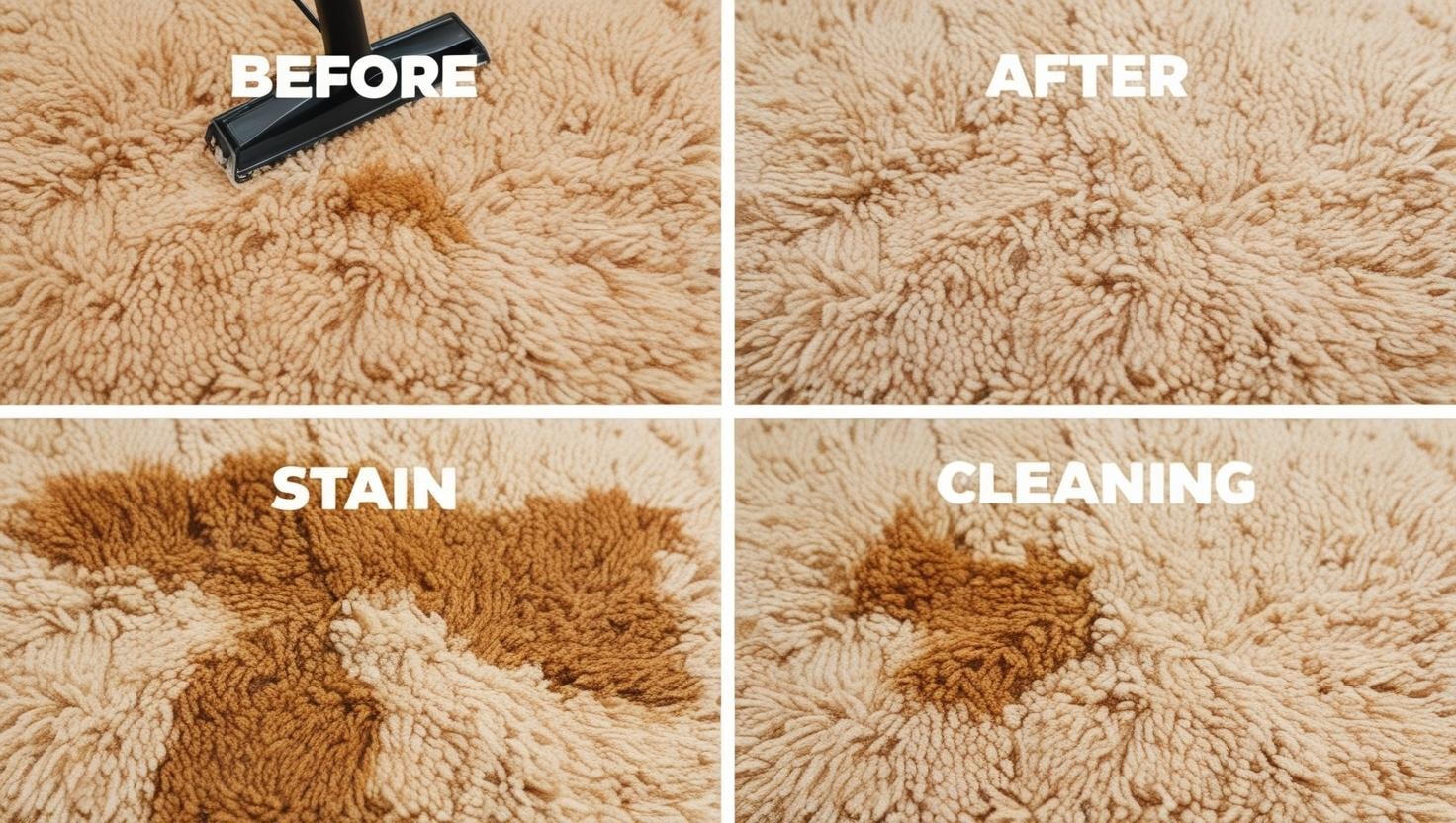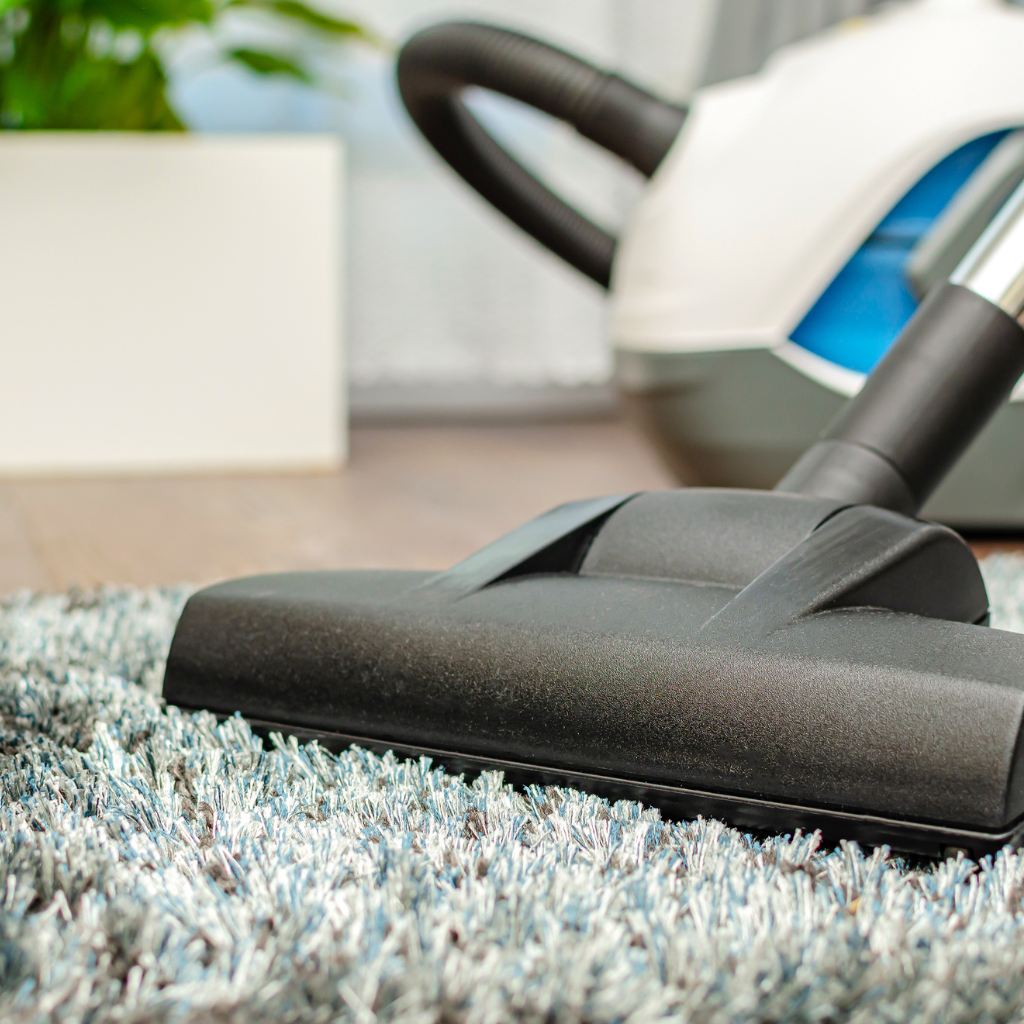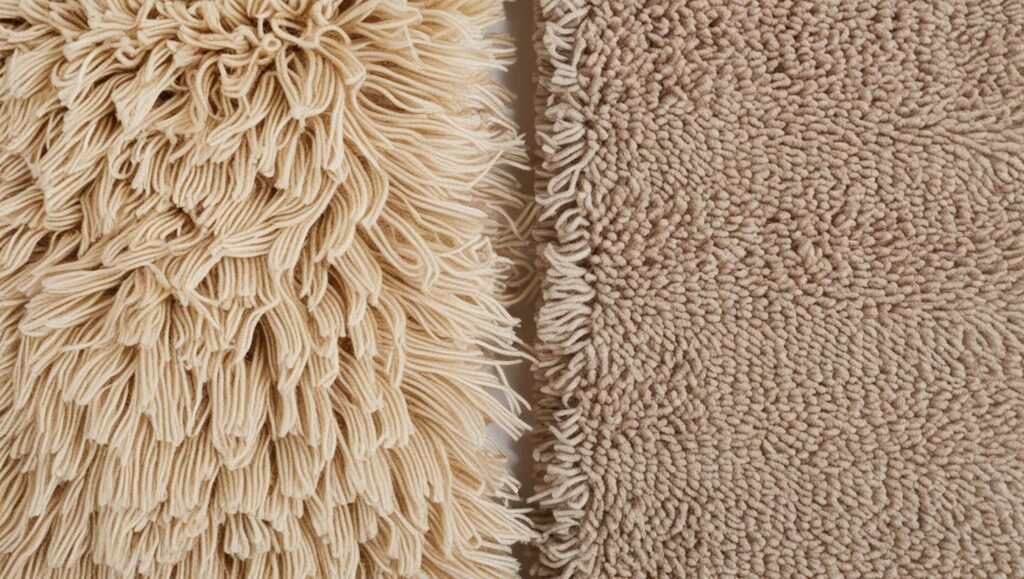To effectively clean loop pile wool carpets, begin by vacuuming at least twice a week using a suction-only vacuum cleaner, which avoids beater bars or rotating brushes that can damage the loops. For stain removal, promptly blot spills with paper towels, using warm water and a mild detergent specifically safe for wool. Apply the solution gently without rubbing to prevent fibre damage and matting. Test any cleaning solution on a hidden area first to make sure there are no adverse effects. By following these guidelines, your loop pile carpet remains vibrant and intact, fostering a pristine appearance through proper care and handling. More information follows on maintaining your carpet's luxurious feel and texture.
Loop pile carpet is a type of flooring characterised by its uncut yarn loops, which form a robust and durable surface ideal for high-traffic areas.
To fully appreciate its maintenance needs, it is imperative to understand the various carpet types and, specifically, the unique properties of loop pile constructions.
Additionally, its dense looped surface provides a natural resistance that can help prevent rug movement when rugs are placed over it, making it a practical choice for layered carpet settings.
Employing the correct cleaning techniques is vital to prevent damage to the carpet pile, thereby extending its lifespan and maintaining its aesthetic appeal.
Understanding the construction of loop pile carpet is essential, as it features continuous yarn loops that are both durable and designed to handle high foot traffic effectively. This type of carpet, often found in wool carpets, offers a unique blend of resilience and aesthetic appeal. Its structure contrasts with cut pile carpets, where the tops of the carpet fibres are sheared off to create a softer, plusher feel.
Loop pile carpet, with its uncut loops, maintains a more even surface, which significantly aids in the longevity and maintenance of the carpet's appearance. The loops are tightly constructed, making the carpet less prone to matting and crushing compared to softer cut pile versions. This makes looped carpets an excellent choice for areas with significant activity, as the durability of the pile fibres can withstand considerable wear.
In terms of carpet care, a vacuum cleaner fitted with a non-beater bar head is ideal to prevent pulling on the loops, which could lead to damage. Regular vacuuming helps remove dirt and debris, maintaining the integrity and appearance of the loop pile carpet. Proper maintenance ensures that wool carpets and other materials in loop pile constructions continue to provide beauty and functionality over time.
Several distinguishing features define loop pile carpet, making it a preferred choice for both commercial and residential spaces that experience high foot traffic. Characteristically, loop pile carpet consists of yarns that are looped and secured into the backing, creating a smooth, level surface. This structure enhances the carpet's durability and resistance to crushing and matting, making it ideal for areas with frequent activity.
Wool carpet, a common type of loop pile, offers additional benefits, including natural stain resistance and ease of maintenance. Regular vacuuming is vital to maintaining and cleaning such carpets effectively. Using a vacuum cleaner with a rotating brush bar is recommended to agitate the fibres gently, lifting dust and dirt, which can otherwise accumulate and degrade the fabric. However, it is essential to balance this with care to avoid damaging the loops.
Regular professional cleaning appointments are advisable to clean the carpet and remove more stubborn stains. Between these sessions, prompt stain removal is key to preserving the appearance and longevity of the carpet. Successfully managing these elements helps extend the life of a loop pile carpet, ensuring it remains a practical and attractive flooring option.

To maintain the integrity of loop pile carpets, it is essential to employ specific techniques that prevent damage to their distinctive looped fibres. When vacuuming is completed, it's vital to use a vacuum that adjusts to the particular needs of loop pile carpets. Ideally, one should avoid using a beater bar or a rotating brush, as these can snag and unravel the loops, severely damaging the carpet pile. Instead, opt for a suction head that cleans them effectively without being overly abrasive.
Furthermore, while cleaning, it's crucial to make sure that the carpet does not become overwet. Excessive moisture can lead to the fibres becoming matted, which can flatten the carpet and reduce its aesthetic appeal and longevity. Techniques such as using a damp cloth to blot stains rather than dousing the area with water are advisable.
To effectively remove stains from wool loop carpets, it is crucial to address spills promptly using paper towels and blotting techniques. This helps absorb moisture without driving the stain deeper into the fibres.
Choosing safe cleaning detergents designed explicitly for wool guarantees that the carpet's integrity and colour are preserved while effectively lifting stains.
Additionally, immediate action can prevent stains from becoming embedded, simplifying maintenance and extending the carpet's lifespan.
When addressing stains on wool loop carpets, promptly using paper towels to blot the affected area is an essential first step in preventing the stain from settling deeper into the fibres. It is vital to act quickly when spills occur. Lay paper towels over the spill and gently blot, applying pressure to absorb as much of the liquid as possible. Avoid rubbing the stain, as this can cause the fibres to mat and the stain to spread.
After removing the initial excess moisture with paper towels, replace them with a clean cloth dampened with warm water. Continue the blotting process using a dabbing motion rather than a wiping one. This method helps to lift the stain out of the carpet fibres without causing further spread.
If necessary, you can apply a small amount of mild detergent to the cloth, ensuring it does not contain any harsh chemicals that could damage the wool. Again, use only gentle pressure during this step to prevent the carpet backing from becoming overly wet, which can lead to additional damage.
These techniques, combining the use of paper towels, warm water, and mild detergent with careful blotting and dabbing, are effective in managing stains on wool loop carpets while preserving their integrity and appearance.
Preventing stains from becoming embedded in wool loop carpets requires timely and effective action, using appropriate cleaning methods and tools. Immediate attention to spills is vital. Begin by gently dabbing the spill with a white cloth, absorbing as much liquid as possible without rubbing, which can push the stain deeper into the carpet fibres.
For best maintenance, it is important to vacuum regularly with a suction-only vacuum cleaner. This type of vacuum avoids the use of brushes or beaters that can damage the delicate pile of wool carpet while effectively removing dirt and dust that, if left unattended, can lead to embedded stains.
After vacuuming, if a stain persists, additional measures may be necessary. Apply a small amount of water with a clean, white cloth and continue to dab the stain gently. This method helps to lift the stain without the use of harsh chemicals that could damage the wool fibres.
Regular maintenance, including vacuuming and prompt spill removal, forms the first line of defence in keeping your wool loop carpet pristine, preventing dirt from settling deep into the pile and ensuring the longevity and aesthetic appeal of your carpet.
Maintaining the appearance and texture of loop pile carpets requires a clear understanding of their unique structure, which includes both twisted and looped strands.
Regular care practices, using suitable vacuum tools and addressing spills without delay, are essential to preserve the integrity of the carpet fibres.
Additionally, scheduling professional cleaning appointments can be a crucial part of the maintenance routine to guarantee deep cleaning and longevity of your loop pile carpets.
To maintain the unique texture and appearance of loop pile carpets, it is essential to understand the nuances of their twisted and looped strands. The way the strands are twisted and looped directly influences both the durability and the aesthetic quality of these carpets.
Loop pile carpets are designed with loops of yarn that are either left as is or occasionally twisted before being woven into the backing. This structure not only adds depth and texture but also impacts how the carpet should be cleaned and maintained.
When aiming to clean this material, it's essential to take into account the distinct characteristics of the fibres. The looped nature of these carpets means they can hide dirt well, but they also tend to hold onto it. Consequently, regular vacuuming with an upright vacuum cleaner is recommended to maintain the look and feel of the carpet without damaging the fibres.
However, the vacuum cleaner alone may not suffice for deep cleaning. For thorough removal of embedded dirt and potential allergens, employing a professional cleaner with greater cleaning power is advisable. These professionals can utilise techniques and equipment that are appropriate for the delicate nature of twisted and looped fibres, ensuring a deeper clean without compromising the carpet's integrity.
Regular care and timely maintenance are key to preserving the texture and appearance of loop pile carpets. To keep your carpet looking its best, frequent vacuuming is essential. Loop pile carpets, particularly those made from wool, are prone to holding dirt and debris within their fibres. It is advisable to vacuum at least twice a week using a cleaner with a gentle suction setting to prevent pulling the loops, which could potentially damage the carpet.
When it comes to stain removal, acting promptly is essential. Blot spills immediately with cold water before applying any cleaning solution; hot water can cause wool fibres to shrink. For tougher stains, a mixture of mild detergent and cold water can be effective. Still, it's essential to test this on a small, inconspicuous area first to guarantee colourfastness and material integrity.
Professionals are well-versed in the nuances of wool carpets and recommend these methods to avoid long-term damage. Remember, the goal is not just to clean your carpet but to maintain its luxurious feel and intricate texture. By adhering to these care practices, you ensure your loop pile carpet remains a centrepiece in your home for years to come.
While daily care routines are important, periodic professional cleaning appointments play an essential role in extending longevity and preserving the aesthetic of loop pile carpets. Professional carpet cleaning services are equipped with advanced techniques and tools that guarantee thorough cleaning without damaging the delicate fibres of your carpet.
Here are several reasons why professional cleaning appointments are significant:
Incorporating professional cleanings into your maintenance schedule helps ensure your carpets remain beautiful, clean, and durable, maximising your investment in home décor.

Understanding the distinctions between loop pile and cut pile carpets is essential for selecting the appropriate carpet for different areas of your home or business.
Loop pile carpets, characterised by their durable, uncut yarn loops, offer a robust option suitable for high-traffic areas. On the other hand, cut pile carpets feature sheared fibre tips, providing a softer feel underfoot.
When evaluating these two types of carpets, it is vital to take into account their respective looks, durability, maintenance needs, and suitability for various room environments to make an informed choice.
When comparing loop pile and cut pile carpets, one immediately notices distinct differences in texture and aesthetic appeal. Loop pile carpets, often made from wool, offer a durable and cosy surface. Their loops are uncut, forming a smooth and consistent texture ideal for high-traffic areas.
In contrast, cut pile carpets feature fibres that are cut at the ends, creating a softer, plusher feel, which adds a luxurious touch to interiors.
For maintaining the pristine condition of loop pile wool carpets, certain practices are essential:
These characteristics and care strategies highlight the functional and aesthetic differences between loop pile and cut pile carpets, guiding appropriate maintenance and use.
Durability and maintenance needs vary greatly between loop pile and cut pile carpets, primarily due to their construction and material composition.
Loop pile carpets, often made from wool, are renowned for their resilience. The continuous yarn loops are better at resisting matting and crushing, making them suitable for high-traffic areas. However, when it comes to stain removal, loop pile carpets can be more challenging. The tight loops can hold spills near the surface, but this also means that when a liquid spill occurs, prompt action is essential to prevent the stain from setting.
On the other hand, cut pile carpets, with their fibres cut at the ends, create a softer, more plush pile. This luxurious feel, however, can be prone to showing footprints and vacuum tracks. Additionally, the fibres in cut-pile carpets can fray or show signs of wear more quickly than loop-pile carpets.
For maintenance, vacuuming cut pile carpets typically requires a cleaner with a beater bar or rotating brushes to lift the fibres and ensure a thorough clean. In contrast, loop pile carpets can often be effectively cleaned using a suction-only vacuum to prevent snagging and pulling of the loops.
When selecting carpeting for different rooms, consider the distinct advantages of loop pile and cut pile carpets to match the specific needs and traffic levels of each space.
Loop pile carpets are characterised by their looped fibres, which are durable and excellent for high-traffic areas, maintaining their appearance under heavy use. Conversely, cut pile carpets feature fibres that are cut at the ends, creating a softer, more plush surface ideal for bedrooms and living rooms where comfort is a priority.
Choosing the appropriate carpet style involves understanding its unique attributes:
Whether you wish to install a new carpet or replace an existing one, consider whether a cut-loop carpet could offer the best of both worlds, blending durability with plush comfort.
To effectively safeguard your loop pile carpet from the detrimental effects of soil and dirt, it is essential to implement preventive measures that not only preserve the carpet's appearance but also extend its lifespan.
One practical approach is the strategic use of baking soda, which can absorb moisture and remove odours, thereby aiding in the maintenance of the carpet's integrity.
Additionally, it is important to understand the negative impact of over-wetting on the carpet piles, as excessive moisture can lead to damage and reduce the carpet's durability.
Implementing routine maintenance and protective strategies can significantly reduce the accumulation of soil and dirt in loop pile carpets, preserving their appearance and longevity. For wool carpets, understanding the material is essential to applying the correct preventive measures.
Regular vacuuming is essential, as it prevents soil from embedding deeply into the carpet's fibres. When addressing spills, it is vital to dab the affected area gently and never use harsh chemicals or over-wet the carpet, as this can damage the wool fibres.
Incorporating these preventive measures can extend the life and beauty of your loop pile carpets:

Applying baking soda effectively removes soil from loop pile carpets, safeguarding their texture and extending their lifespan. For wool carpets, in particular, the gentle, non-abrasive properties of baking soda make it an excellent choice for regular soil removal.
To utilise baking soda efficiently, first make sure the carpet is free of any loose debris by thoroughly vacuuming. This essential pre-treatment step is vital as it prevents dirt from further embedding into the carpet's fibres during the cleaning process.
Next, sprinkle a generous amount of baking soda directly onto the soiled areas of the carpet. Using a soft sponge, gently work the baking soda into the carpet. For enhanced effectiveness, dilute a tablespoon of baking soda in a quart of warm water, creating a mild solution. Apply this to the carpet with the sponge, dabbing rather than scrubbing to maintain the integrity of the loop pile.
Allow the baking soda to sit for at least 15 minutes before vacuuming it up. This waiting period lets the baking soda absorb the soil, easing its removal. The result is not just superficial cleanliness but a more profound purification of the carpet, promoting a fresh, hygienic, and aesthetically pleasing environment.
Understanding the impact of over-wetting on carpet piles is essential, as excessive moisture can lead to significant damage, such as matting, discolouration, and the growth of mould and mildew.
When cleaning loop pile carpets, particularly wool carpets, it is essential to manage the amount of moisture used. Over-wetting not only affects the aesthetic appeal of the carpet but also its durability and overall hygiene.
To mitigate the risks associated with over-wetting, consider the following practical approaches:
In summary, maintaining loop pile carpets, particularly those made of wool, necessitates targeted approaches for vacuuming, stain removal, and general upkeep to preserve their distinctive texture and resilience.
Understanding the structural differences between loop pile and cut pile carpets enhances effective care practices.
Proactive measures, including regular cleaning and the implementation of preventive strategies, are essential to safeguard these carpets from soil and wear, thereby extending their aesthetic appeal and functional life.